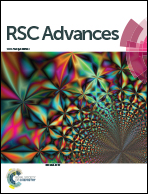A near-infrared photoinverter based on ZnO and quantum-dots
Abstract
Near-infrared (NIR) photoswitching transistors have been fabricated using a hybrid structure of zinc oxide (ZnO) and quantum-dots (QDs). The ZnO active layer was prepared using a solution process, while colloidal QDs were inserted between a silicon dioxide (SiO2) gate insulator and a ZnO active layer. The small band gap QDs (1.59 eV) were used to absorb low-energy NIR photons, generate photo-excited carriers, and inject them into the conduction band of the ZnO film. The device with the interfacial QDs induced photocurrents upon exposure to 780 nm-wavelength light. The photoresponsivity of the ZnO/QD device was 0.06 mA W−1, while that of the device without QDs was 1.7 × 10−5 mA W−1, which indicated that the small band gap QDs enabled a photo-induced current when exposed to NIR light. Furthermore, a photoinverter was prepared which was composed of a ZnO/QDs phototransistor and a load resistor. Photoswitching characteristics indicated that the photoinverter was well modulated by a periodic light signal of 780 nm in wavelength. The results demonstrate a useful way to fabricate NIR optoelectronics based on ZnO and QDs.



 Please wait while we load your content...
Please wait while we load your content...